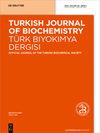强效抗病毒药物1-[(2-氨基苯基)硫]-1-苯基-2-硝基丁烷衍生物的遗传毒性
IF 0.7
4区 生物学
Q4 BIOCHEMISTRY & MOLECULAR BIOLOGY
Turkish Journal of Biochemistry-turk Biyokimya Dergisi
Pub Date : 2014-01-01
DOI:10.5505/TJB.2014.25238
引用次数: 1
摘要
目的:首次采用umu-微孔板检测系统对6种设计为药物的硝基罗布烷(I)衍生物进行基因毒性检测。药物开发的一个重要原则是在体外试验中对先前确定的显著药物活性进行安全性试验。这可能比它在实验条件下的效率更重要,因为在化疗中对患者无风险的治疗是很重要的。方法:专门设计umu -微孔板检测系统,用于检测硝基化合物的致突变性。1-[(2-氨基苯基)硫]-1-苯基-2-硝基丁烷(I)衍生物含有硝基。因此,我们选择umu-微孔板检测系统进行分析。采用鼠伤寒沙门菌NM1011(过表达硝基还原酶)和鼠伤寒沙门菌NM2009(过表达O-At (o -乙酰基转移酶))对硝基化合物敏感,采用微孔板检测系统评价所检测化合物的SOS诱导活性。以氯酚红-β- d-半乳糖苷(CPRG)和o -硝基苯基-β-双乳糖苷(ONPG)为底物,以4-硝基喹啉- 1-氧化物(4NQO)为阳性对照。结果:虽然使用CPRG的β-半乳糖苷酶活性比使用ONPG的高3倍,但所有化合物对底物和菌株都有相似的结果。对于所有化合物,发现过表达NR和O-At的菌株对umuC基因表达的诱导作用几乎相同。所测试的衍生物对两种菌株的过表达NR和O-At酶没有明显的诱导作用,这两种酶在硝基化合物的代谢激活机制中起作用。结论:我们的研究表明,1-[(2-氨基苯基)硫]-1-苯基-2-硝基丁烷衍生物在该试验系统中无遗传毒性作用。这一结果是一个非常重要的数据,使它们成为潜在的候选药物。本文章由计算机程序翻译,如有差异,请以英文原文为准。
Genotoxicity of potent antiviral 1-[(2-aminophenyl)thio]-1-phenyl-2-nitrobutane derivatives designed as drug agents
Objective: Genotoxic potentials of six selected nitrobutane (I) derivatives designed as drug agents were tested here for the first time using umu-microplate test system. An important principle in drug development is to perform safety tests of previously determined significant drug activity in in vitro assays. This may be even more crucial than its efficiency in terms of experimental conditions, since it is important in chemotherapy to treat without risk for the patient. Methods: Umu-microplate test system is especially designed for detecting the mutagenicity of nitro compounds. 1-[(2-aminophenyl)thio]-1-phenyl-2-nitrobutane (I) derivatives involve nitro groups. Therefore umu-microplate test system has been chosen for our analysis. Evaluation of the SOS inducing activity of the tested compounds was examined with the umumicroplate test system using Salmonella typhimurium NM1011 (overexpressed NR (nitroreductase)) and S.typhimurium NM2009 (overexpressed O-At (O-acethyltransferase))strains which are sensitive to nitro compounds. Chlorophenol red-β-D-galactopyranoside (CPRG) and O-nitrophenyl-β-Dgalactopyranoside (ONPG) were used as substrate in the enzyme assays and also the well-known genotoxic nitro compound, 4-nitroquinoline 1-oxide (4NQO), was the positive control in the test. Results: Although the β-galactosidase activities with using CPRG were three fold higher than ONPG, parallel results were obtained for both substrates and strains with all compounds tested. For all compounds, the induction of umuC gene expression was found to be almost the same for the strains that overexpress NR and O-At. The derivatives tested didn’t caused an evident induction in both strains overexpressed NR and O-At enzymes which have a role in metabolic activation mechanism of nitro compunds. Conclusion: Our study showed that, 1-[(2-aminophenyl)thio]-1-phenyl-2-nitrobutane derivatives have no genotoxic effects in this test system. This result is a very important data making them a potential drug candidate.
求助全文
通过发布文献求助,成功后即可免费获取论文全文。
去求助
来源期刊
CiteScore
1.20
自引率
0.00%
发文量
0
审稿时长
6-12 weeks
期刊介绍:
Turkish Journal of Biochemistry (TJB), official journal of Turkish Biochemical Society, is issued electronically every 2 months. The main aim of the journal is to support the research and publishing culture by ensuring that every published manuscript has an added value and thus providing international acceptance of the “readability” of the manuscripts published in the journal.

 求助内容:
求助内容: 应助结果提醒方式:
应助结果提醒方式:


